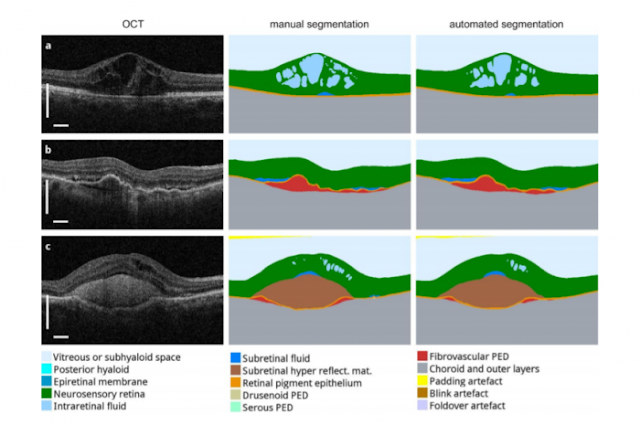Case Study - Methods
Using AI to tackle disease, from monitoring, to detection, to lifestyle management. Google’s strategy involves an end-to-end approach to healthcare, including:
- Data generation — This includes digitising and ingesting data produced by wearables, imaging, and MRIs among other methods. This data stream is critical to AI-driven anomaly detection.
- Disease detection — Using AI to detect anomalies in a given dataset that might signal the presence of some disease.
- Disease/lifestyle management — These tools help people who have been diagnosed with a disease or are at risk of developing one go about their day-to-day lives and/or make positive lifestyle modifications
Google's DeepMind artificial intelligence research company is developing a clinical decision support (CDS) tool for identifying eye diseases. Researchers from DeepMind are progressing towards a clinical decision support product that can accurately identify more than fifty eye diseases and provide treatment recommendations for patients. The company is working with the Moorfields Eye Hospital in the UK to improve on this prior eye disease research and assist eye doctors in assessing the risk of a patient’s eye problem and directing them to medical care based on the urgency of the condition. "Currently, eye care professionals use optical coherence tomography (OCT) scans to help diagnose eye conditions. These 3D images provide a detailed map of the back of the eye, but they are hard to read and need expert analysis to interpret," explained DeepMind. Using deep learning, the research team is able to automatically detect relevant eye features in seconds, and can flag patients at high risk of serious complications to bring their cases to the front of the diagnostic queue. Initial results, published in Nature Medicine, show that the deep learning tool developed by DeepMind and Moorfields Eye Hospital can identify, diagnose, and recommend care for common clinical eye conditions as accurately as human clinicians (De Fauw, Ledsam and Romera-Paredes, 2018). The algorithm, which is yet to be commercialised, aims to reduce the time to diagnosis for conditions that threaten permanent loss of sight, allowing providers to treat patients or refer them to the correct specialist more quickly. While speed is important, delivering trustworthy and transparent results is an equally critical goal (DeepMind, 2018).
In addition, The team has focused specifically on avoiding the creation of a “black box” system that does not allow users and patients to understand the decision-making pathways behind a recommendation (DeepMind, 2018). By using a dual layered neural network, DeepMind and Moorfields researchers hope to provide adequate explanation – and trustworthy confidence intervals – to supplement the clinical decision support delivery process (DeepMind, 2018). “The first neural network, known as the segmentation network, analyses the OCT scan to provide a map of the different types of eye tissue and the features of disease it sees, such as hemorrhages, lesions, irregular fluid or other symptoms of eye disease,” the team said. The tool has not yet been put through its paces with clinical trials, and has not received regulatory approval that would allow it to be used in the clinical setting just yet. However, the researchers are confident that the preliminary results are a positive step towards developing a product that could alter the way eye care providers diagnose and treat their patients.
Source: DeepMind / Moorfields
References:
- De Fauw, J., Ledsam, J.R., Romera-Paredes, B., (2018). Clinically applicable deep learning for diagnosis and referral in retinal disease. Nat Med 24, 1342–1350. <https://doi.org/10.1038/s41591-018-0107-6>
- DeepMind, (2018). <https://deepmind.com/blog/article/moorfields-major-milestone> Accessed [December] [2021]


Try to improve on paraphrasing secondary information, parts of the information provided in your post sound like it has been copied directly from your sources.
ReplyDelete